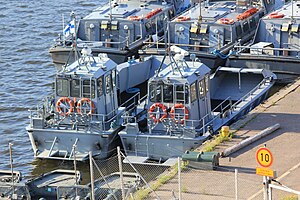
The Finnish Navy is one of the branches of the Finnish Defence Forces. The navy employs 2,300 people and about 4,300 conscripts are trained each year. Finnish Navy vessels are given the ship prefix "FNS", short for "Finnish Navy ship", but this is not used in Finnish language contexts. The Finnish Navy also includes coastal forces and coastal artillery.

The Nyland Brigade, officially Nylands Brigad (NylBr) in Swedish,, is a Brigade-level Marine unit of the Finnish Navy stationed in Dragsvik in Raseborg in the province of Uusimaa. The Brigade trains Coastal Jaegers and other troops for combat in coastal environments. It is the only unit of the Finnish Defence Forces where the instruction language is Swedish, the country's other official language. The command language is, however, Finnish.
A patrol boat is a relatively small naval vessel generally designed for coastal defence, border protection, immigration law-enforcement, search and rescue duties. There have been many designs for patrol boats. They may be operated by a nation's navy, coast guard, police force or customs and may be intended for marine or estuarine or river environments. They are commonly found engaged in various border protection roles, including anti-smuggling, anti-piracy, fisheries patrols, and immigration law enforcement. They are also often called upon to participate in rescue operations.

Landing craft are small and medium seagoing watercraft, such as boats and barges, used to convey a landing force from the sea to the shore during an amphibious assault. The term excludes landing ships, which are larger. Production of landing craft peaked during World War II, with a significant number of different designs produced in large quantities by the United Kingdom and United States.

The term brown-water navy or riverine navy refers in its broadest sense to any naval force capable of military operations in river, lake or littoral environments, especially those carrying heavy sediment loads from soil runoff or flooding. The term originated in the United States Navy during the American Civil War, when it referred to Union forces patrolling the muddy Mississippi River, and has since been used to describe the small gunboats and patrol boats commonly used in rivers, along with the larger "mother ships" that supported them. These mother ships include converted World War II-era Landing Crafts and Tank Landing Ships, among other vessels.

The Jurmo-class landing craft is a type of military transport in use by the Finnish Navy. The manufacturer Marine Alutech designates it as Watercat M12.
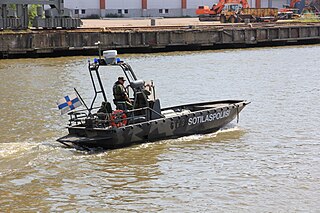
The G class, or "G-boat" also known as the Marine Alutech Watercat M8 landing craft is a type of vessel in use by the Finnish Navy and the Swedish Navy. The G-boat was originally designed for the Swedish Navy which ordered about 100 of them. It is primarily used for amphibious landings by, and transportation of, marines. It has a very low draught at high speeds which makes it ideal for amphibious assault even in shallow waters. It has a cargo capacity of 8 men or one metric ton.

A Landing Craft Utility (LCU) is a type of boat used by amphibious forces to transport equipment and troops to the shore. They are capable of transporting tracked or wheeled vehicles and troops from amphibious assault ships to beachheads or piers.

Stridsbåt 90 H(alv) is a class of fast military assault craft originally developed for the Swedish Navy by Dockstavarvet. In addition to the many variants in service with the Swedish Navy under the "Stridsbåt 90H" designation, the CB 90 has been adopted by the navies of several countries, including Norway, Greece, Mexico, the United States and Malaysia. Additionally, the German Navy plans to equip the Berlin-class replenishment ships with the CB90.
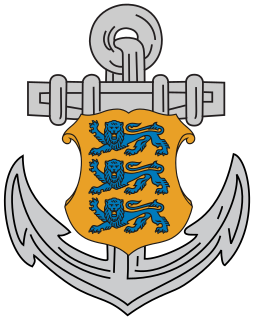
The Estonian Navy are the unified naval forces among the Estonian Defence Forces.

NEMO is a single barrelled 120 mm remote-controlled mortar turret currently being developed by Patria Land Oy in Finland. It is a lighter version of the AMOS mortar system, which has been in use within the Finnish Defence Forces since 2013. The NEMO can be fitted to most APCs and also to smaller landing craft, such as the Finnish Jurmo-class landing craft or the Swedish CB90-class fast assault craft.

The Zubr class is a class of Soviet-designed air-cushioned landing craft (LCAC). This class of military hovercraft is, as of 2012, the world's largest, with a standard full load displacement of 555 tons. The hovercraft was designed to sealift amphibious assault units from equipped/non-equipped vessels to non-equipped shores, as well as to transport and plant naval mines.

The Royal Bahamas Defence Force (RBDF) is the military of The Bahamas. Since The Bahamas does not have an army or an air force, its navy composes the entirety of its armed forces. Under The Defence Act, the Royal Bahamas Defence Force has been mandated to defend The Bahamas, protect its territorial integrity, patrol its waters, provide assistance in times of disaster, maintain order in conjunction with the law enforcement agencies of The Bahamas, and carry out any such duties as determined by the National Security Council. The Defence Force is also a member of CARICOM's Regional Security Task Force. The task force has seen action in the United Nations mandate in Haiti 1994.

An amphibious warfare ship is an amphibious vehicle warship employed to land and support ground forces, such as marines, on enemy territory during an amphibious assault. The largest fleet of these types is operated by the United States Navy.

The Marine Assault Team (MAST), formally known as Royal Malaysia Police Combat Divers Unit is a maritime special operations squad, and part of the Royal Malaysia Police's Marine Operations Force. Fully operational on 2007, the UNGERIN conducts anti-piracy and counter-terrorism operations in the coastal waters surrounding Malaysia and assists the marine police to respond swiftly.
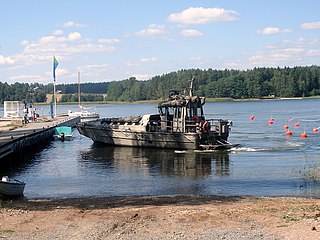
The Watercat M14 landing craft is a type of military transport in use by the Royal Malaysia Police. The manufacturer is Marine Alutech Oy Ab, Finland
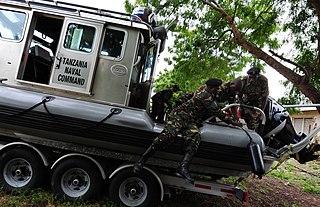
The Tanzania Naval Command is the naval branch of the Tanzanian Armed Forces. It was established in 1971 with assistance from China.

Jehu-class landing craft are a class of military transport vessels used by the Finnish Navy. Manufactured by Marine Alutech under the designation Watercat M18 AMC, the boats can perform a multitude of tasks ranging from troop transport and landing operations to patrolling and escort tasks as well as combat and battle support operations. The Jehu-class boats are considerably larger and better armed that the preceding Jurmo-class landing craft.
